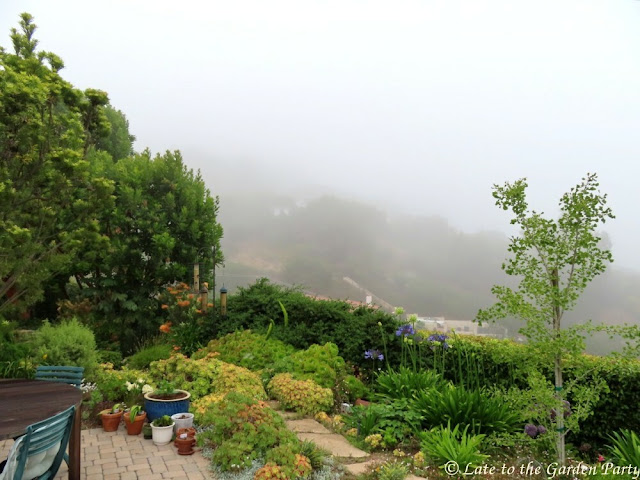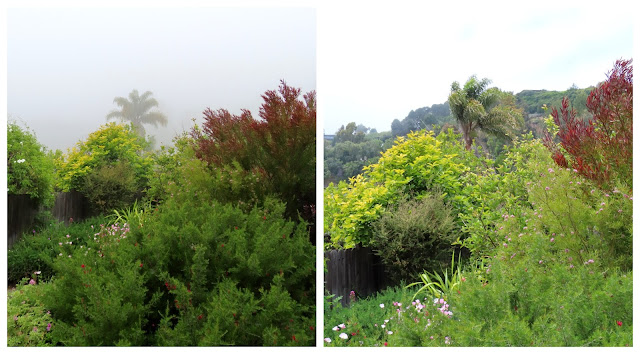The title of this post isn't a commentary on my current mood (although it's somewhat descriptive). "June Gloom" is a common term for the marine layer that's characteristic of the weather along California's coast at this time of year. It's not limited to the month of June either - it can occur as early as April ("Graypril") or May ("May Gray") and as late as September. (There are names for July and August, "No Sky July" and "Fogust" too but, for some reason, I haven't found one for September.) The marine layer usually emerges during the overnight hours and gradually lifts sometime in early to mid-afternoon, depending on its strength and how far one is from the coast.
I admit to a momentary sense of disappointment whenever I open the blinds in the morning to see overcast skies without a touch of blue but the marine layer offers benefits by keeping temperatures down, which is especially helpful during the summer months. While much of California suffered through high temperatures last week due to the so-called "heat dome" hovering over our state, it remained cool and comfortable here. In fact, it's often referred to alternately as nature's air conditioning or a heat shield.
In the garden, it creates a "Twilight Zone" like sense of being cut off from the world around us.
 |
| View from my back door yesterday morning looking east |
 |
| View from the back patio looking northeast |
 |
| Homes on the other side of the canyon were visible but just barely |
 |
| View from the front garden looking northwest. Taking photos during these conditions is often easier and some colors stand out particularly well. |
 |
| View from the south-side of the garden looking south. You can see the outline of a neighbor's house down the street if you look very closely. |
The marine layer hides a lot.
The eeriest aspect of the phenomenon in my opinion is evident when the mist moves in - or out. It's hard to catch in a photo.
 |
| This closeup of Callistemon 'Cane's Hybrid' provides a peek at the shifting mist. It's like walking through a cloud. |
The marine layer is reportedly more pronounced when the La Niña climate pattern is in place. It's also relatively uncommon in other parts of the world. Recent studies suggest that climate change may eventually put an end to it. A 2018 study offered evidence that California's coastal stratus clouds have declined twenty to fifty percent since the 1970s. A 2019 study undertaken by CalTech showed that increased carbon dioxide in the atmosphere may eventually wipe out those stratus clouds entirely. (You can find references to both studies here.) If that happens, it'll probably mean higher temperatures, contributing further to general global warming; plants struggling for moisture due to heightened levels of evaporation, which may not be available due to persistent drought conditions; and an increased number of wildfires. None of those things is good.
Our current ten-day weather forecast shows continuation of the marine layer at full strength through this Friday, diminishing on Saturday, and disappearing on Sunday, before returning with less vigor during the balance of next week. The marine layer may deliver mist and even a bit of drizzle but we don't often receive anything in the way of measurable rain from it, although our roof-top weather station shows we collected 0.01/inch of precipitation last week. Every bit counts.
All material © 2012-2024 by Kris Peterson for Late to the Garden Party

Love that marine layer, not only for its huge benefit to costal California but also to the cool photo ops. It feels familiar and comfortable to me, similar to the gray sky in Seattle. It means gardening without hat, sunglasses, sun screen etc. and there's no need to water anything but potted plants: a blessing.
ReplyDeleteChavli
Yes! Although the cooler temperatures slow down the progression of summer blooms (the lily bloom stalks currently seem frozen in place), they do prevent plant foliage and soil from drying up in a nanosecond. As if Mother Nature was denying my closing remarks about precipitation, the marine layer delivered another 0.01/inch this morning too.
DeleteYour marine layer sure makes for some lovely pictures of the garden and view! My car is in the shop, and so I walked to my dental cleaning at 3pm. It was 101 yesterday, I could've used some of those clouds.
ReplyDeleteUgh, 101! As if a trip to the dentist wasn't already a pain. I hope cooler days are in the forecast for later this week, Tracy.
DeleteWe get this "gloom" in June as well, and in fact right this very moment as I type (9:30 am) it is starting to lift. I share your feelings of disappointment when it occurs, I want every bit of sunshine I can possibly get, temperatures be damned. Thanks for sharing the names of the gloom in other months, I hadn't heard some of them!
ReplyDeleteWell, I won't actually damn the marine layer for lowering our temperatures as I detest temperatures in the upper nineties, not to speak of those above 100, Loree. My feelings about mid-summer are roughly equivalent to your feelings about the height of winter. The saving grace with the marine layer is that, most days, we can count on the sun showing up in the somewhere between 1-3pm.
DeleteI'm a big fan of June Gloom and it seemed to be lessening as a feature when I was full time in Long Beach approx 3 years ago, so maybe La Nina is helping out. I suspected climate change might be lessening its occurrence, and there you have the stats right there! I was trying to find Cane's Hybrid to trial up here and had it on order but it never came through -- what a sight!
ReplyDeleteI wasn't aware of any La Nina/El Nino connection to the marine layer until I read it while preparing this post, Denise. The reference (in Wikipedia, if I remember correctly) indicated that the marine layer lessened in frequency or may be absent altogether when El Nino is in effect.
DeleteAnnie's carries Callistemon 'Cane's Hybrid', although it's currently shown as out of stock. Starting with a 4-inch pot would be slow but at least it wouldn't cost the proverbial arm and a leg.
I revel in these cooler overcast days--hours in the garden without ever feeling overheated. And the plants like it too!
ReplyDeleteYour ghostly photos are lovely and express the beauty of these days.
If the marine layer could keep us cool throughout the summer, I'd be happy, HB. With longer days ahead of us, afternoon sun is just fine.
DeleteIt gives a sense of privacy, doesn't it? :) A blessing on a hot day, I would think. It is scary to think the marine layer might cease to exist... a death knell for the north coastal redwoods. 🥹
ReplyDeleteYou mentioned sound being diminished, the moisture does absorb sound... it is what it is like here when it snows. I love that hush. Eliza
We're lucky that the marine layer is back this morning, although with the smoke from a wildfire to the north of us, it's currently hard to tell how much of the "fog" is moisture and how much is smoke :(
Delete